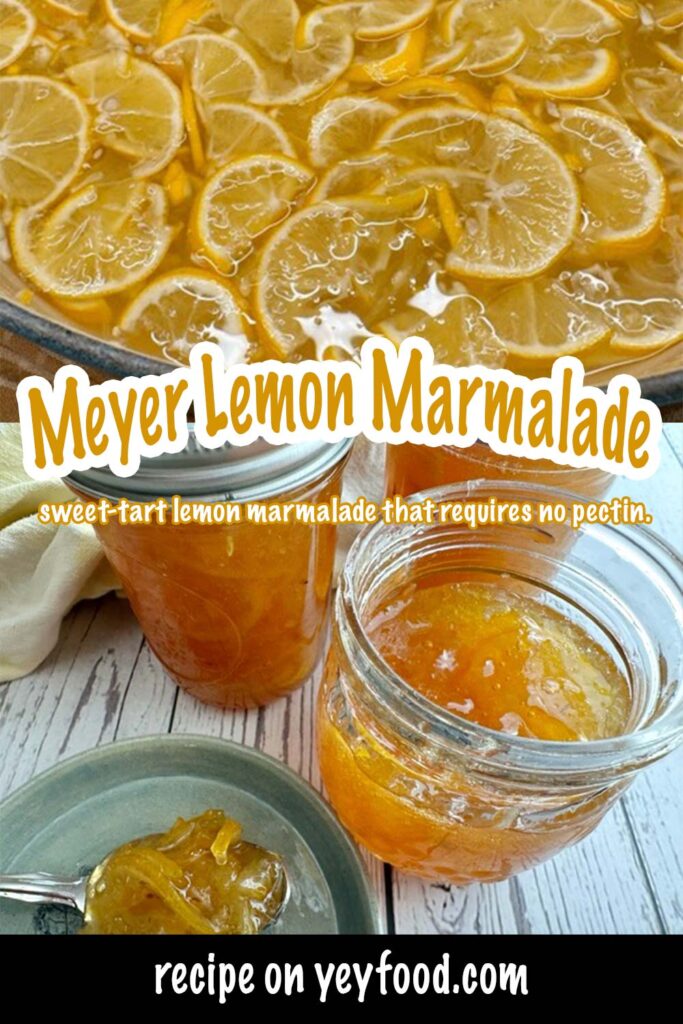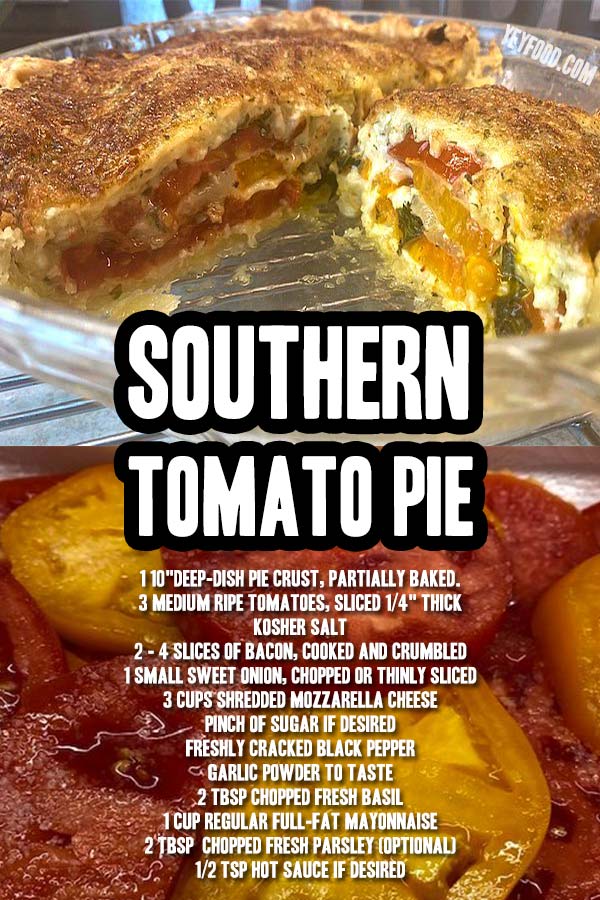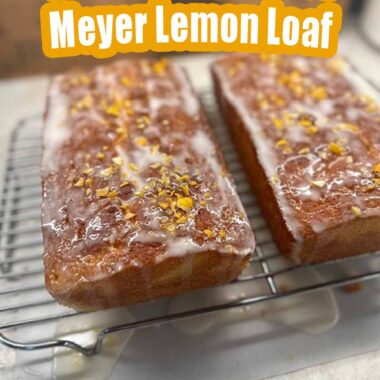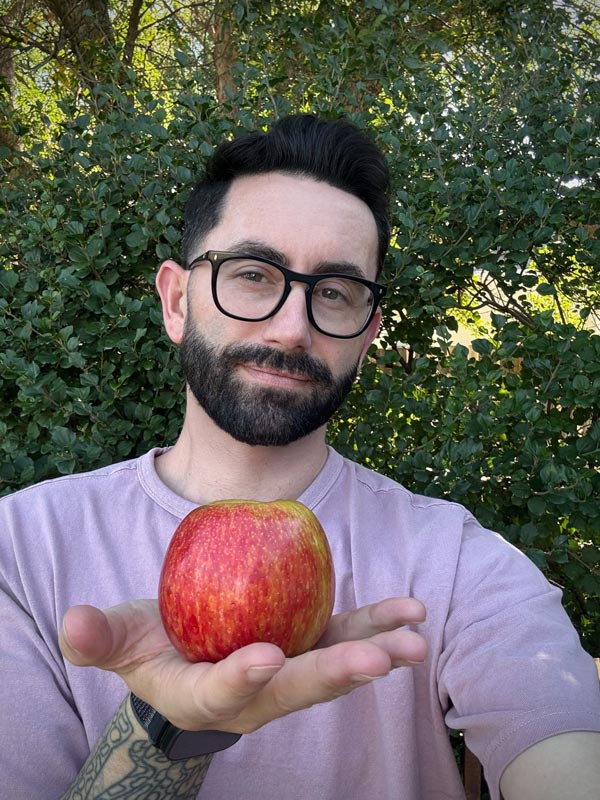Absolutely Delicious, And You Don’t Need Pectin
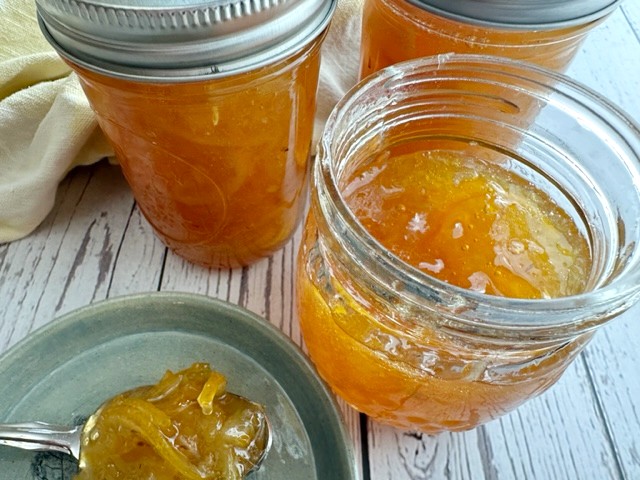
Meyer lemons don’t grow in Nebraska, but thanks to a California friend, I got a bag of them and was determined to make some lemon marmalade with them! I love lemon anything, and orange marmalade is a favorite, so I knew I would love this amazing lemon marmalade!
All you need are Meyer lemons, water, and sugar. There is enough pectin in the seeds to make the marmalade gel! It’s easy to make and will taste amazing on scones, biscuits, or thumbprint cookies!
Meyer lemons do not grow in Nebraska; they are a warm-climate fruit, and we seldom see them in grocery stores here. I am lucky to have a sweet friend who brought some back from a trip to Arizona and shared!!
When they lived in Los Angeles, she and her husband had a Meyer lemon tree in their yard, and that’s how she fell in love with this wonderful little citrus fruit that’s really not quite a lemon.
Meyer lemons get their name from Frank Meyer, an agricultural explorer who discovered them in China while working with the US Department of Agriculture. Meyer lemons are named for him, but they were likely cultivated for thousands of years before he brought them to America in 1908.
Meyer lemons are believed to be a cross between a regular lemon and a mandarin orange. They are about the same size as a lemon, but the skin is smoother, deeper in color, and much thinner.
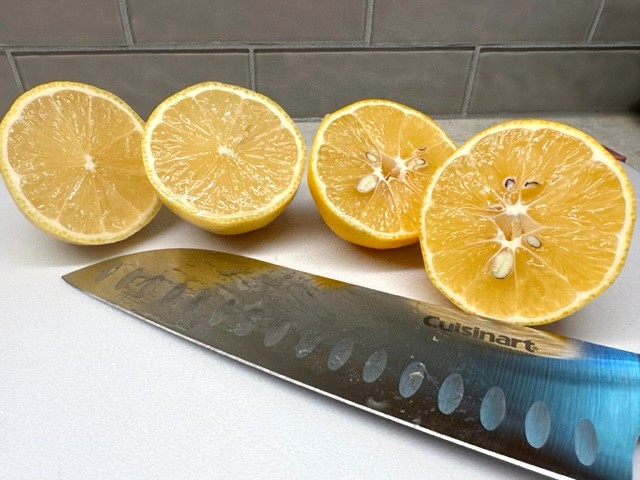
Meyer lemons are very sweet, and there is no white pith layer; the whole fruit can be used, even the skin, but not the seeds. The flesh and juice are sweeter than a regular lemon and can be used raw or cooked. In this lemon marmalade, every part of the fruit is utilized.
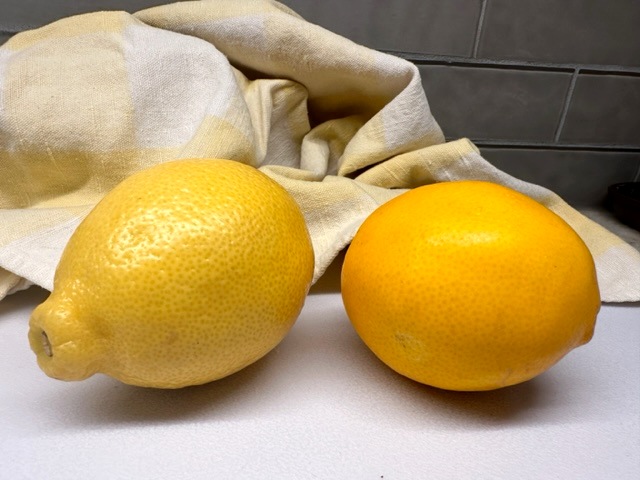
How To Make Six Gorgeous Half-Pint Jars Of Lemon Marmalade
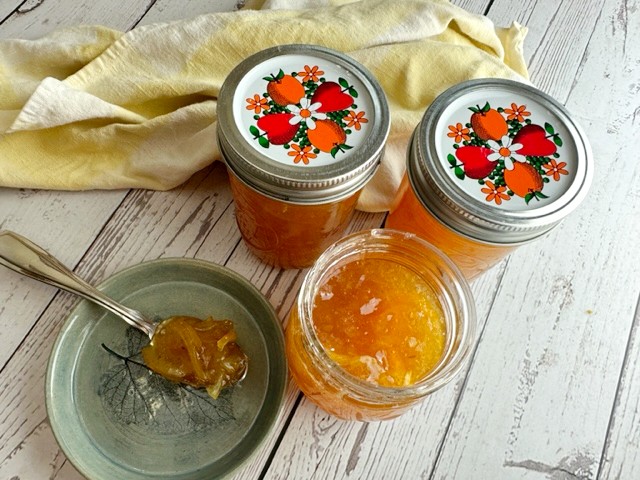
Wash the lemons and cut each one in half, remove and save as many seeds as possible, and set them aside. Slice the lemons as thin as possible and put them in a large non-reactive pot (like enamel or stainless steel.)
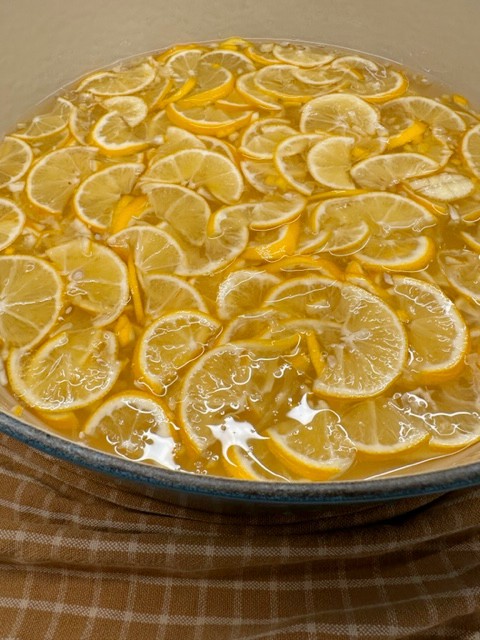
Tie up the seeds in a cheesecloth bag. I did not have any cheesecloth, so I emptied a family-size tea bag, put the seeds in it, and used the string to tie it shut. Sometimes you have to channel your inner McGuyver in the kitchen. 😉
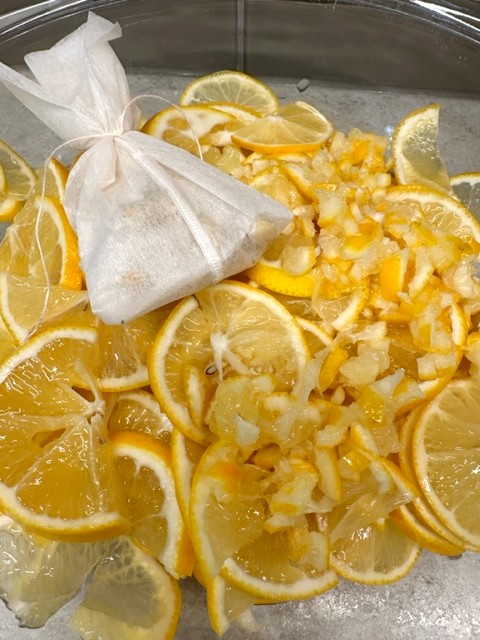
Add water and the bag containing seeds in a large non-reactive pot, cover, and let it soak for 24 hours, or at least overnight. This allows the pectin in the seeds to release and infuse the water and the lemons to break down a little bit. It is not necessary to refrigerate them.
Bring the mixture to a boil, then turn the heat down to a simmer and allow the contents to reduce by about half. You should have about 4 cups remaining. You will want to keep an eye on this and stir it from time to time, so try to bustle around in the kitchen for a while. There’s always something to clean or wipe down while you watch. Especially the refrigerator! Ugh!
Remove the seed bag, add the sugar and keep at a low boil, stirring occasionally and skimming off any foam. Put a small glass plate or bowl in the freezer for a “gel test” to see when the marmalade is ready.
You can tell when the marmalade begins to gel because the mixture starts boiling quite vigorously as it thickens. Use a long spoon and maybe even an oven mitt. This sugary mixture gets even hotter than boiling water!
If you are a newbie to canning and jam-making, please refer to my post How to Have The Sweetest Jam Session In Your Kitchen, where I go into great detail about everything you need to have and know for happy trails in making jam and lemon marmalade!
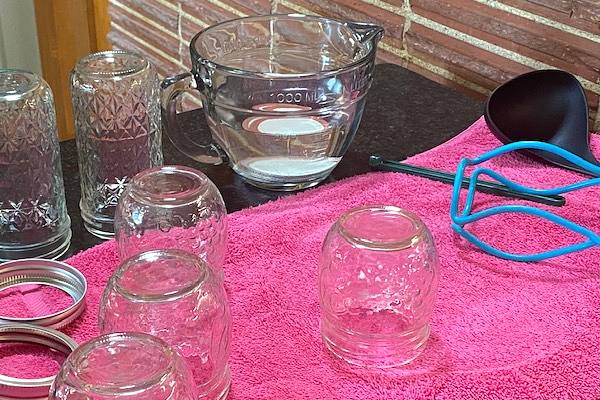
Test the lemon marmalade by putting about a teaspoon on the cold plate and putting the dish back into the freezer for a couple of minutes. Take it out and tilt it. If the marmalade runs, it’s not ready and needs to cook a little longer.
If it firms up and gets a little “skin” on it, it’s prepared to put into your eight-ounce jelly jars. Ladle the marmalade into sterilized jars, leaving a 1/2-inch space at the top. Seal the jars with lids and screw on the band.
Process the jars in a boiling water bath for ten minutes, then remove them to a cooling rack where they can sit undisturbed until they are completely cool and you have heard the jars seal with the distinctive “pop” sound.
If they do not seal, keep the marmalade refrigerated, the marmalade packed in jars will last a year at room temperature.

Meyer Lemon Marmalade
Here is a recipe for sweet-tart lemon marmalade that requires no pectin.
Ingredients
- 1 1/2 pounds Meyer lemons (about 6–7)
- 4 cups water
- 4 cups granulated sugar
- Cheesecloth and string to tie up the seeds, or empty a tea bag and tie it shut.
Instructions
- Wash the lemons.
- Cut each lemon in half, remove as many seeds as possible, and set them aside.
- Slice the lemons as thin as possible.
- Tie up the seeds in a cheesecloth bag.
- Add water and the bag containing seeds in a large non-reactive pot, cover, and let it soak for 24 hours, or at least overnight. This allows the pectin in the seeds to release and infuse the water and the lemons to break down a little bit. It is not necessary to refrigerate them.
- Bring the mixture to a boil, then turn the heat down to a simmer and allow the contents to reduce by about half. You should have about 4 cups remaining. You will want to keep an eye on this and stir it from time to time, so try to hang around the kitchen while this happens. It takes a while.
- Remove the seed bag, add the sugar and keep at a low boil, stirring occasionally and skimming off any foam.
- Put a small glass plate or bowl in the freezer for a "gel test" to see when the marmalade is ready. You can tell when the marmalade is beginning to gel because the mixture starts boiling quite vigorously as it thickens.
- Test the marmalade by putting about a teaspoon of marmalade on the cold plate and putting the dish back into the freezer for a couple of minutes. Take it out and tilt it. If the marmalade runs, it's not ready and needs to cook a little longer. If it firms up and gets a little "skin" on it, it's prepared to put into jars.
- Ladle the marmalade into sterilized jars, leaving a 1/2-inch space at the top. Seal the jars with lids and screw on the band.
- Process the jars in a boiling water bath for ten minutes, then remove them to a cooling rack where they can sit undisturbed until they are completely cool and you have heard the jars seal with the distinctive "pop" sound.
- If they do not seal, keep the marmalade refrigerated,
- Marmalade sealed in jars will last a year at room temperature.
Nutrition Information:
Yield: 48 Serving Size: 1Amount Per Serving: Calories: 65Total Fat: 0gSaturated Fat: 0gTrans Fat: 0gUnsaturated Fat: 0gCholesterol: 0mgSodium: 1mgCarbohydrates: 17gFiber: 0gSugar: 17gProtein: 0g
We love how the old kitchen arts of canning and freezing are back, and more young cooks enjoy this rewarding activity. Here are some of our favorite canning and pickling recipes. Corn Cob Jelly, Peony Jelly, How To Freeze Corn, Anything Goes Pickles, and if you need more ideas- use the search bar on the homepage!
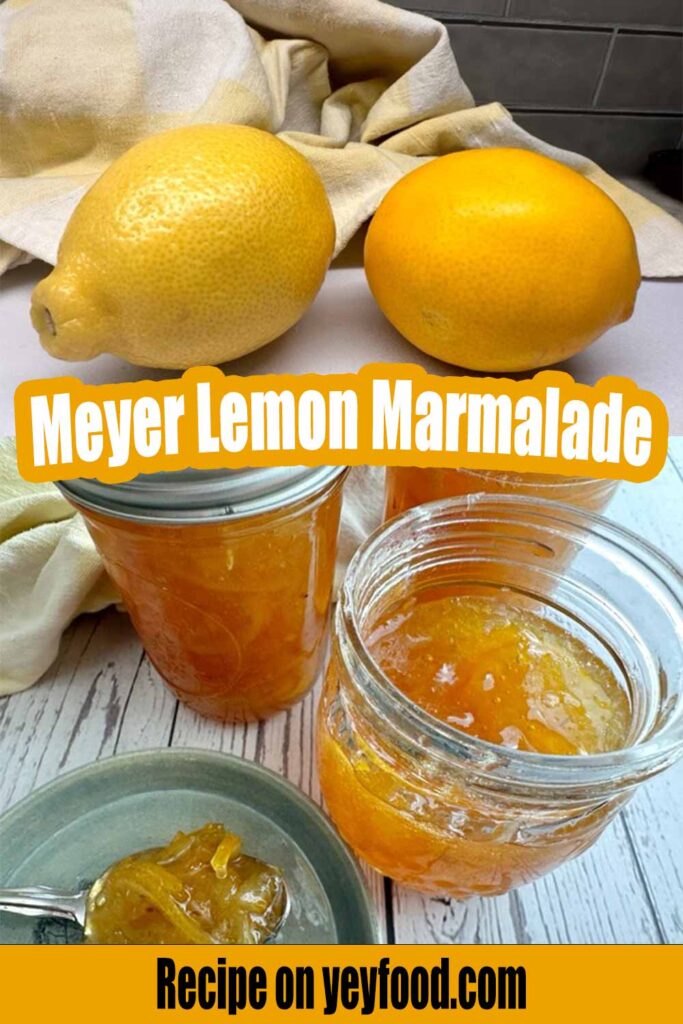
More recipes from us
4 Reasons You Should Freeze Some Sweet Corn This Summer
How To Make The White BBQ Sauce That’s Fascinated Us Since 1925
Dilly Pickled Green Beans You Make In Your Refrigerator
If you like these recipes, you are our people! You can check some related articles below or search via categories on the right. But be warned; you will be on here for hours. Enjoy!
So, please share this recipe on your social media accounts like Facebook, Instagram, Twitter, and Pinterest. We would be honored and ever so grateful; thank you!
